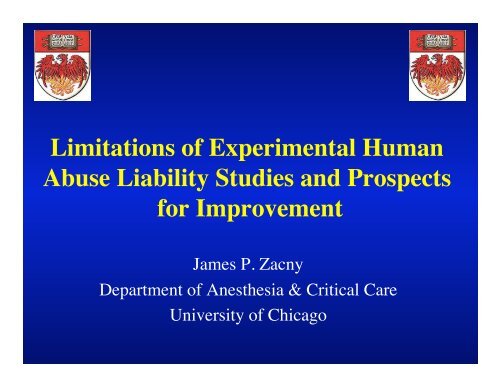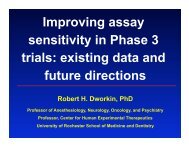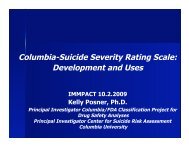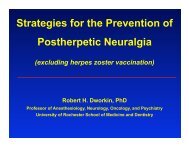Limitations of Experimental Human Abuse Liability ... - immpact
Limitations of Experimental Human Abuse Liability ... - immpact
Limitations of Experimental Human Abuse Liability ... - immpact
- No tags were found...
Create successful ePaper yourself
Turn your PDF publications into a flip-book with our unique Google optimized e-Paper software.
<strong>Limitations</strong> <strong>of</strong> <strong>Experimental</strong> <strong>Human</strong><strong>Abuse</strong> <strong>Liability</strong> Studies and Prospectsfor ImprovementJames P. ZacnyDepartment <strong>of</strong> Anesthesia & Critical CareUniversity <strong>of</strong> Chicago
Outline <strong>of</strong> Presentation• Issues relating to human ALA <strong>of</strong> opioid ADFs• Issues relating to human ALA <strong>of</strong> opioids ingeneralALA= abuse liability assessmentADF=abuse-deterrent formulation
Issues Relating to <strong>Human</strong> ALA <strong>of</strong>Opioid ADFs• An added component to traditional ALA when testingADF’s: extractability testing• What is the appropriate subject population for ALA <strong>of</strong>ADF opioids?• When doing IN and IV ALA, should the extract fromthe ADF formulation be used?
Issues Relating to <strong>Human</strong> ALA <strong>of</strong> ADF’s• What kind <strong>of</strong> ALA testing needs to be done withADFs?• Differences in latency to peak positive effects <strong>of</strong>IR vs. ADF ER opioids...how much does itmatter?• What constitutes a clinically significant reductionin abuse liability <strong>of</strong> an ADF?
An Added Component to Traditional ALAWhen Testing ADF’sExtractability (Benchtop) Testing
• Why do it?Extractability Testing– We know abusers are going to try to circumvent theabuse deterrent aspect <strong>of</strong> the formulation• To enhance the drug effect (to increase cmax)• To achieve a faster onset <strong>of</strong> effect (to decrease tmax)• To alter formulation to allow for different route <strong>of</strong>administration (from oral to either snorting or iv use)• To remove undesirable ingredients (ACET, NLTX)
Major Issues Related ToExtractability Testing• What materials are needed for extraction studies? • Crushing equipment; solutions/chemicals; heating/freezingequipment• From an abuse deterrent perspective…– The more materials needed and the more esoteric theyare in order to extract, the better the ADF– The more complicated the extraction process is and themore time consuming, the better the ADF
Major Issues Related ToExtractability Testing• How much <strong>of</strong> the opioid can one extract from the ADF?– Example: 120 mg MOR ADF ER• 20 mg (good ADF) vs. 100 mg (hmmm…)• With ADFs that have other products in them that areundesirable to the abuser, how much <strong>of</strong> those productscan be extracted (removed)?• Examples: aversives (blockers, niacin, capsaisin; acetaminophen, talc/binders)• More aversives that can be removed, more likely that the ADF will besnorted or injected
Extractability (Benchtop) Testing:The Problem• “Neither the FDA nor the DEA haveobjective criteria to measure extractability.” • “Standardized laboratory extraction must bedeveloped for each type <strong>of</strong> formulation (e.g.,tablet, capsules, patches) using solvents andequipment commercially available.”Robert Bianchi from his talk on “Extractability: How Should It Be Measured”2006 THCI Opioid Risk Management meeting
Extractability Testing: A TemplateKatz and colleagues designed a system to measure the ease/difficulty by which the opioid can be extracted from theformulation (e.g., ADF). (Katz et al., 2006 Drug Develop IndPharmacy 32:727-746)However, to date there appear to be no industry-wide standards onextractability testing.
2. What is the appropriate subject population forALA <strong>of</strong> ADF opioids?• Consensus in ALA community is thatsubjects…– must be recreational users <strong>of</strong> prescriptionopioids– must be able to detect an effect <strong>of</strong> an opioidwith known abuse liability, and show a positiveresponse to that opioid– if going to be testing IN or IV route, the usershould have a history <strong>of</strong> such use• However, no criteria on usage history
2. What is the appropriate subject population?Drug Age Number <strong>of</strong>times usedrecentlyIR with anaversiveER opioidA - ADFER opioidA - ADFER opioidB - ADFNumber <strong>of</strong>times usedin last yearDSM-IVOpioid UseDisorder18-55 - - yes no18-55 At leastonce in last3 monthsAt least 10times18-50 - At least 5times18-65 At leastonce in last30 daysIR opioids ? (28.6) ? (1-2Xweekly)nonoPrescreenfor likingnoyes- no yes? ? not clear
2. What is the appropriate subject population?• Different criteria on use (recent or last year)problematic in studies designed to test abuseliability in nonmedical users– As an example…• Two studies examine abuse liability <strong>of</strong> Opioid X– one study looks at users with a light history (5X/yr)– another study looks at users with a heavier history (1-2X/wk)– Ensuing result: possible variability in key endpoints anddifferent interpretations <strong>of</strong> abuse liability <strong>of</strong> Opioid X
2. What is the appropriate subject population forALA <strong>of</strong> prescription opioids?• Heroin abusers?– Not for testing <strong>of</strong> oral opioids that are likely tobe abused orally• Heroin abusers might rate their liking relative to howmuch they like iv heroin (Fraser et al., 1961, 1978)• Increases risk <strong>of</strong> a Type II error– Possibly for studies which assess abuse liability<strong>of</strong> an ADF via the iv route• In fact since the majority <strong>of</strong> POAs swallow intact orchew*, might be hard to do such an ALA with POAs * Katz et al. 2008 Internet-based survey <strong>of</strong> nonmedical prescription opioid use in the US. Clin J Pain24:528-535
3. When doing IN and IV ALA, should theextract from the ADF formulation be used?
3. When doing IN and IV ALA, should theextract from the ADF formulation be used?• Intranasal• IV– How safe is insufflating ground drug product? (i.e.,does it have excipients that could be harmful tosubject?)– Does one try and filter and inject extracted drug afterheating it in a teaspoon, or…– Does one administer a suitable parenteral dosagebased on recovery from benchtop tampering studies?Wright et al. 2006 Drug Alcohol Depend 83S:S68-S76
3. When doing IN and IV ALA, should theextract from the ADF formulation be used?• Example <strong>of</strong> a potential IV ALA study: – tampering produces a less-than-pure substance (e.g., solutionis slightly viscous or contains particulates but can still loadinto a syringe)– it would be important to know if iv prescription opioidabusers would still like the product– questionable as to whether this could be ethically tested• “Evaluating these issues…is subject to practical andethical constraints that are always difficult, and <strong>of</strong>tenpresent insurmountable barriers toaccomplishment.” (Wright et al., 2006)
4. What kind <strong>of</strong> ALA testing needs tobe done with ADFs?
4. What kind <strong>of</strong> ALA testing needs tobe done with ADFs?• Conditions– The intact ADF (2-3 doses)– The IR that contains the same opioid in ADF,in order to show reduced liability (1-2 doses)– Placebo– In some cases the tampered ADF • If opioid is likely to be crushed, then a crushedproduct• Gets dicier with intranasal and iv routesMcColl and Sellers 2006 Drug Alcohol Depend 83S:S52-S62, 2006
5. Latency to peak positive effects <strong>of</strong> IR vs. ADFER opioids...how much does it matter?– According to the rate-<strong>of</strong>-onset hypothesis, drugs that hit the brainfaster and produce peak effects soon after administration are more“rewarding” than those that produce peak effects after someprolonged period <strong>of</strong> time.– “… issue that deserves consideration is the weighting <strong>of</strong> the early(e.g., up to 3 h post-dose) and later subjective reports for IRcompared to ER formulations”. (McColl and Sellers, 2006)– Should there be a cut<strong>of</strong>f (e.g., within 3 hours post-drug) in whichabuse-liability related effects are given more weight? A “criticalwindow”…?
5. Latency to peak positive effects <strong>of</strong> IR vs. ERopioids...how much does it matter?• A study that illustrates the weighting issue:– In a published abstract the following formulations anddoses were tested:• 8 mg IR opioid (positive control)• 8 mg (crushed), 16, 32, and 64 mg <strong>of</strong> ADF ER opioid• placebo– Results• All doses and formulations produced higher liking ratingsthan placebo.• Maximum drug liking for the 32- and 64-mg ADF ER wassimilar to 8-mg IR, but occurred later (15 h vs. 2 h).
5. Latency to peak positive effects <strong>of</strong> IR vs. ERopioids...how much does it matter?• So... the ER formulation at high doses hadequivalent liking ratings as a lower dose <strong>of</strong>an IR formulation albeit at a later time point. • How much should the delayed liking <strong>of</strong> theER formulation be “discounted”? – Should that ER formulation be considered anADF?
The issue <strong>of</strong> weighting due to rate <strong>of</strong>onset not cut-and-dried…“However, despite this generally accepted theoretical framework(i.e., rate <strong>of</strong> onset), the empirical database is limited and thepredictive validity <strong>of</strong> changes seen in well-controlledexperimental studies examining differences in rates <strong>of</strong> absorptionto post-marketing deterrence <strong>of</strong> abuse is inadequatelycharacterized.”
6. What constitutes a clinicallysignificant reduction in abuseliability <strong>of</strong> an ADF to warrant aspecific mention in the PI?
6. What constitutes a clinically significantreduction in abuse liability <strong>of</strong> an ADF?* ** *0=dislike a lot; 50=neutral; 100=like a lot
6. What constitutes a clinically significantreduction in abuse liability <strong>of</strong> an ADF?* ***How does one evaluate the “lowered” abuse liability <strong>of</strong> the ER productwhen it produces more liking than placebo? Maybe taking two <strong>of</strong> theER tablets would elevate liking to the same degree as the IR product.
6. What constitutes a clinically significantreduction in abuse liability <strong>of</strong> an ADF?*** *
Some issues that relate to humanopioid ALA in general1. Does ALA have predictive validity?2. Have ALA instruments been validated?3. Is there the need for, or would it be desirable,to standardize primary outcome measures inALA?
Does ALA have predictive validity?• Does it predict real world abuse?– Well…. yes and maybe– Yes• If ALA study reveals that Drug X shows no signs <strong>of</strong> abusepotential in abusers, extremely unlikely the drug will beabused in the world (e.g., diphenhydramine)– Maybe• If an abuse liability study reveals Drug Y shows strongsignals <strong>of</strong> abuse potential in abusers, the drug may beabused in the real world.
Does ALA have predictive validity?• The concept <strong>of</strong> ”necessary but not sufficient”• An opioid must show signals indicative <strong>of</strong> abuse liabilityfor it to be considered as a potential drug <strong>of</strong> abuse in thereal world. – But it is not SUFFICIENT in predicting real world abuse• Other factors play important roles in actual abuse <strong>of</strong> anopioid:– Its availability (if not readily available, less abuse)– Its cost (in and <strong>of</strong> itself and relative other opioids)– What other peers are abusing (e.g., drug d’jour)– Potency (low potency, low abuse)
Have ALA instruments been validated?• IN ALA, there are multiple ways to measureabuse liability– Most subjective measures that do notnecessarily measure the same thing showconcordance on abuse liability <strong>of</strong> an opioid• e.g., MBG (Euphoria), Liking and Take Again– This would seem to argue typical measures <strong>of</strong>abuse liability possess construct validity– However, novel measures to assess abuseliability should be subjected to validation testing
Is there the need to standardizeprimary outcome measures inopioid ALA?
CPDD Expert Panels recommendation• 2003 (ALA <strong>of</strong> CNS Drugs)– “Researchers should be encouraged to standardize somepsychometric scales (e.g. drug liking scales) for humanALA studies, in order to facilitate comparisons acrossALA across research laboratories and across drugs.”• 2006 (Drug Formulation and <strong>Abuse</strong> <strong>Liability</strong>)– “Continued standardization <strong>of</strong> the primary outcomemeasures used in abuse potential studies should beencouraged to permit more systematic comparisonsacross studies.”Drug Alcohol Depend 70: S107-S114, 2003; Drug Alcohol Depend 83S:S77-S82, 2006
So what should the primary outcomemeasure be?• In review articles <strong>of</strong> ALA, drug liking isconsidered one <strong>of</strong> the most, if not the most,sensitive and reliable measure <strong>of</strong> abuse liability• Current “problem” is that liking is measured inabuse liability studies in a number <strong>of</strong> differentways
• BipolarDrug liking– VAS: 0= dislike a lot; 50=neutral; 100=like a lot– Discrete scale:• 1=dislike a lot; 4=neutral; 7=like a lot• -4=dislike a lot; 0=neutral; +4=like a lot• Unipolar– VAS: 0=not at all; 100=extremely– Discrete scale: 0=not at all; 1= a little bit; 2=moderately;3=quite a bit; 4=very much
Issues Discussed:A number <strong>of</strong> them unresolved…• An added component to traditional ALA when testing ADF’s: extractabilitytesting• What is the appropriate subject population?• When doing IN and IV ALA, should the extract from the ADF formulation beused?• What kind <strong>of</strong> ALA testing needs to be done with ADFs?• Latency to peak positive effects <strong>of</strong> IR vs. ER opioids...how much does itmatter?• What constitutes a clinically significant reduction in abuse liability <strong>of</strong> anADF?• Does ALA have predictive validity?• Have ALA instruments been validated?• Is there the need to standardize primary outcome measures in ALA?
Acknowledgments• Kenzie Preston, Ph.D.• George Bigelow, Ph.D.• Eric Strain, M.D.• Craig Rush, Ph.D.• Lynn Webster, M.D.• Sandra Comer, Ph.D.








